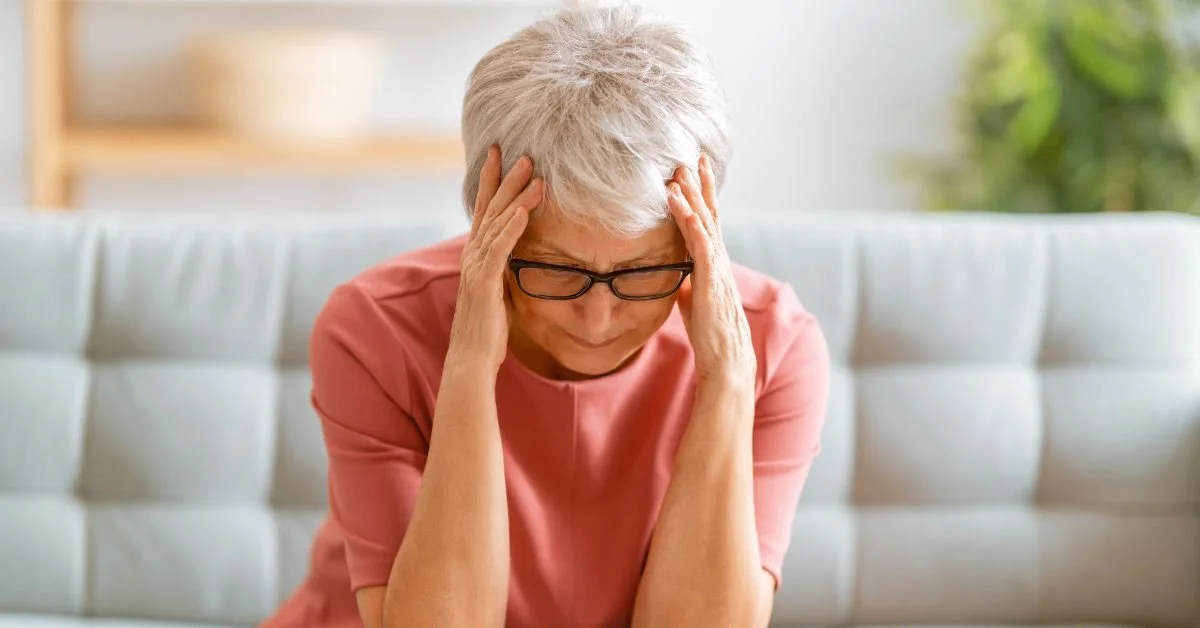Menopausal Migraines: Understanding the Connection and Finding Relief
Menopause is a natural phase in a woman's life, it marks the end of her reproductive years and brings significant hormonal shifts. While it's often associated with hot flashes and mood swings, there's another, less discussed occurrence in menopause that many women struggle with: migraines. And these aren't just your typical headaches; they're often more severe, persistent, and challenging to manage. We’ll explore in this blog everything you need to know about menopausal migraines, why they happen, and of course how to find relief when they are happening.
Understanding Menopause
Menopause is defined as the point in time when a woman has not had a menstrual period for 12 consecutive months. It typically occurs between the ages of 45 and 55, although the exact timing varies from person to person It signals the cessation of ovulation, which means that the ovaries no longer release eggs. This is attributed to a decline in the production of crucial hormones, primarily estrogen and progesterone.
Connection of Hormones and Migraines
Estrogen and progesterone are important hormones that play different roles in a woman's body. These hormones are not only in charge of the menstrual cycle and fertility but also influence various bodily functions, including mood regulation, bone density maintenance, and even vascular health. The connection between hormonal fluctuations and migraines is a complex one. While the exact mechanisms remain the subject of ongoing research, it's widely recognized that estrogen, in particular, exerts a profound influence on migraine development.
During the menstrual cycle, estrogen levels fluctuate, rising and falling in a somewhat predictable pattern. For many women, the drop in estrogen that occurs just before menstruation can trigger migraines. This is commonly referred to as menstrual migraines and is often characterized by intense headache pain, often accompanied by nausea, vomiting, and sensitivity to light and sound.
As estrogen levels eventually decline during premenopause (the period leading up to menopause), women may experience more frequent and severe migraine.
Identifying Menopausal Migraines
Migraines can be excruciatingly painful and debilitating. Identifying these migraines is crucial for effective management. Here are a few symptoms of menopausal migraines and how they differ from normal migraines:
Common Symptoms of Menopausal Migraines:
Throbbing Headache Pain: Menopausal migraines typically involve severe, throbbing head pain. This pain is often localized to one side of the head and can last for hours or even days.
Auras: Some women with menopausal migraines experience auras, which are visual disturbances that can include flashing lights, zigzag lines, or blind spots in their field of vision. Auras may occur before or during the migraine attack.
Nausea and Vomiting: Nausea and vomiting are common accompanying symptoms of menopausal migraines. These gastrointestinal symptoms can further exacerbate the discomfort associated with the headache.
Sensitivity to Light and Sound: Menopausal migraine sufferers often become hypersensitive to light (photophobia) and sound (phonophobia) during an attack. Exposure to bright lights or loud noises can intensify their pain.
Duration: Menopausal migraines tend to be lengthy, with attacks lasting anywhere from a few hours to several days. This extended duration can significantly impact daily life and functioning.
How Menopausal Migraines Differ from Regular Migraines
While menopausal migraines share many characteristics with regular migraines, a few distinctions set them apart.
Hormonal Triggers: Menopausal migraines are uniquely influenced by hormonal fluctuations associated with menopause and perimenopause. They often occur in relation to the menstrual cycle, particularly during the days just before menstruation (menstrual migraines).
Perimenopausal Onset: Some women who never experienced migraines before may begin to do so during perimenopause, adding another layer of complexity to their menopausal transition.
Frequency and Severity: Menopausal migraines may be more frequent and severe than migraines experienced at other life stages due to the unpredictable hormonal changes characteristic of menopause.
Triggers and Contributing Factors of Menopausal Migraines
Menopausal migraines, like migraines in general, can be influenced by a range of triggers and contributing factors. Here are some of the following:
1. Hormonal Fluctuations: Hormonal changes, particularly fluctuations in estrogen levels, remain a primary trigger for menopausal migraines. These fluctuations can occur during the menstrual cycle, perimenopause, or as a result of hormone replacement therapy.
2. Stress: Stress is a well-known migraine trigger. Managing stress through relaxation techniques, mindfulness, and stress-reduction strategies can be immensely beneficial for women experiencing menopausal migraines.
3. Lifestyle Choices: Inadequate sleep, irregular sleep patterns, and excessive or insufficient physical activity can all contribute to migraine onset. Establishing a regular sleep schedule and engaging in regular, moderate exercise can help mitigate these triggers.
4. Environmental Factors: Sensory stimuli like bright lights, loud noises, and strong odors can provoke migraines. Identifying and avoiding such triggers can be helpful.
5. Medications: Certain medications, including hormone replacement therapies and some over-the-counter drugs, can trigger migraines in susceptible individuals. Discussing medication options and potential side effects with a healthcare provider is essential.
6. Dehydration: Dehydration is a known migraine trigger. Staying well-hydrated is a simple yet effective preventive measure.
It's important to note that triggers can vary from person to person. Keeping a migraine diary, where individuals record their activities, dietary intake, and any potential triggers before migraine attacks, can be valuable in identifying and avoiding personal triggers.
Finding Relief From Menopausal Migraines
There are several ways to find relief during menopausal migraines and how to prevent their frequency.
Triptans for Preventive Use
Some triptans have longer half-lives, making them useful for preventing or reducing the severity of menstrual migraines. Examples include frovatriptan (Frova) with a half-life of 26 hours and naratriptan (Amerge) with a half-life of six to eight hours. Longer-acting triptans can be taken a few days before your period to provide preventive relief. This strategy is often referred to as "mini-prophylaxis."
Oral Contraceptives for Reducing Frequency
Certain types of oral contraceptives may reduce the frequency of menstrual migraines. Consult with your gynecologist, primary care doctor, or neurologist to determine which oral contraceptives are suitable for you. Specific oral contraceptives can help stabilize estrogen levels, reducing hormonal fluctuations. Women with migraine, especially those with migraine with aura, should discuss the risks and benefits of oral contraceptives with their healthcare providers.
Daily Magnesium Supplementation
Magnesium is considered a natural supplement that can be taken daily to help prevent menstrual migraines. While the review did not specifically address menstrual migraines, the American Migraine Foundation notes that daily oral magnesium supplements have been effective in preventing menstrual-related migraines, particularly in women with premenstrual migraines. Various types of magnesium supplements are available over the counter, and it's advisable to discuss them with your doctor before starting any supplement regimen.
Hormone Replacement Therapy
Hormone replacement therapy (HRT) can effectively manage menopausal migraines by stabilizing hormone levels, particularly estrogen, which fluctuate during menopause and can trigger migraines. HRT provides a more consistent hormone environment, reducing the hormonal fluctuations that contribute to migraine development. It can also help regulate the menstrual cycle, preventing menstrual-related migraines. However, HRT is not suitable for everyone and carries potential risks, so its use should be carefully discussed with a healthcare provider, considering individual health, medical history, and the severity of migraine symptoms, to make an informed treatment decision.
Self-care
Exercising and self-care practices can help manage migraines by promoting overall health and reducing migraine triggers. Regular physical activity, such as aerobic exercises, can improve blood flow, reduce stress, and release endorphins, which act as natural painkillers. Maintaining a consistent sleep schedule and staying hydrated are essential to prevent migraine triggers. Stress management techniques like mindfulness, meditation, and relaxation exercises can reduce stress-related migraines.
A well-balanced diet that avoids migraine-triggering foods can also play a significant role in migraine management. Additionally, identifying personal migraine triggers and practicing self-awareness can help individuals take proactive steps to minimize migraine attacks.
Stay Hydrated
Hydration is essential to avoid menopausal migraines because dehydration can act as a trigger for migraine attacks. When the body becomes dehydrated, it can lead to changes in blood flow and electrolyte imbalances, both of which are known migraine triggers. Dehydration can also make blood vessels in the brain narrow and become more sensitive to pain, increasing the likelihood of a migraine episode. For menopausal women who are already susceptible to hormonal fluctuations that trigger migraines, staying well-hydrated can help reduce the risk of these painful headaches. Therefore, maintaining proper hydration by drinking an adequate amount of water throughout the day is a simple yet effective strategy to minimize the frequency and severity of menopausal migraines.
Conclusion
Menopausal migraines are a challenge many menopausal women face. There are many factors that can contribute to the occurrence and frequency of migraines. However, there are also many ways to prevent its frequency such as using longer-acting triptans, considering oral contraceptives, daily magnesium supplementation, and hormone replacement therapy.
It's essential for women experiencing menopausal migraines to work closely with their healthcare providers to explore the most suitable treatment options, considering individual health, medical history, and the severity of migraine symptoms. With the right strategies and support, women can navigate the challenges of menopausal migraines and find relief, enhancing their overall quality of life during this significant life transition.
Your journey to a more comfortable and fulfilling life during menopause begins with proactive steps and professional guidance. Don't wait; take charge of your health and well-being today.
Share this blog to spread awareness about menopausal migraines and for many women to know how to manage it properly.

